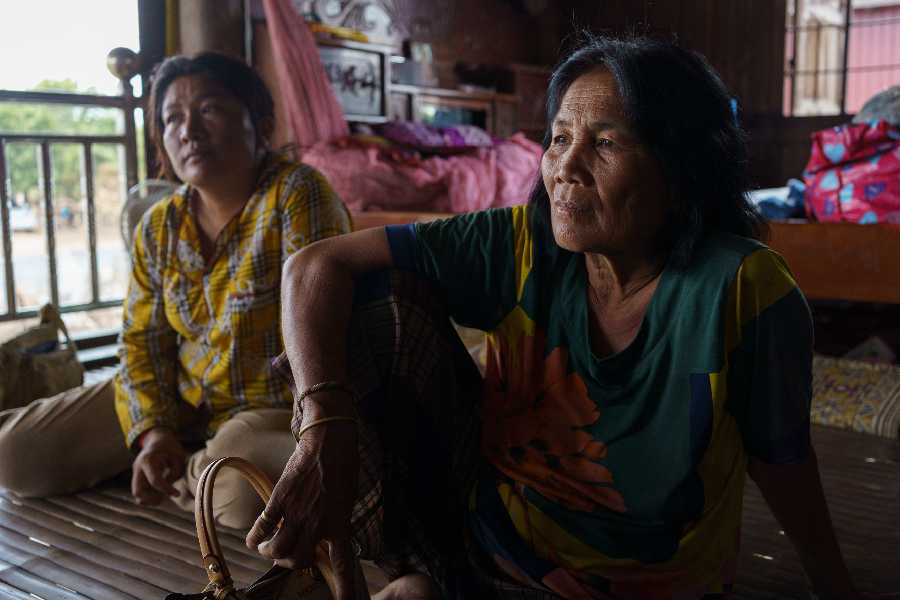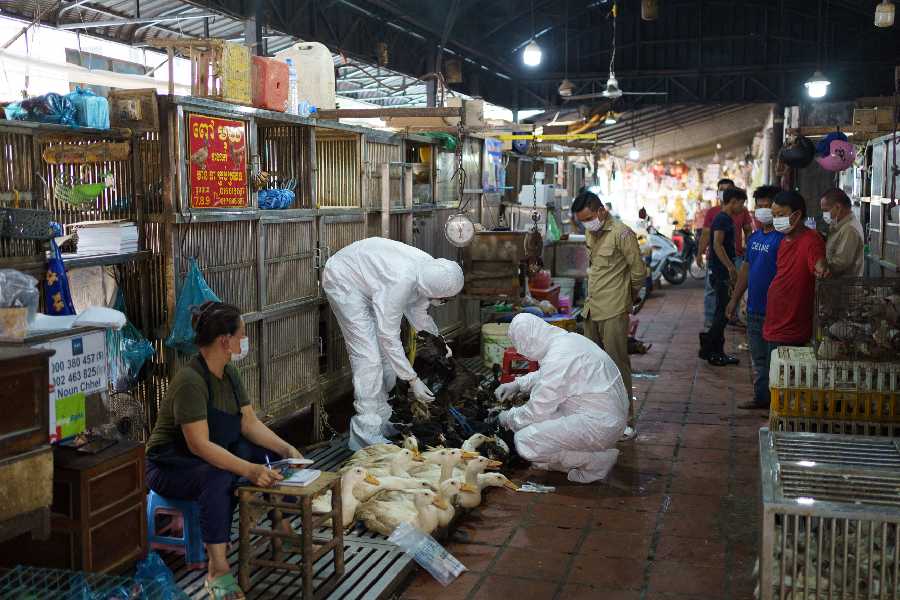As Dr. Sreyleak Luch drove to work the morning of Feb. 8, through busy sunbaked streets in Cambodia’s Mekong river delta, she played the overnight voice messages from her team. The condition of a 9-year-old boy she had been caring for had deteriorated sharply, and he had been intubated, one doctor reported. What, she wondered, could make the child so sick, so fast?
“And then I just thought: H5N1,” she recalled. “It could be bird flu.”
When she arrived at the airy yellow children’s ward at the provincial hospital in Kratie, she immediately asked the child’s father if the family had had contact with any sick or dead poultry. He admitted that their rooster had been found dead a few days before and that the family had eaten it.

Ut Siyeang, left, and Chout Yeng, the mother and a grandmother of Virun Roeurn, a 9-year-old boy who died of H5N1, one of many viruses that cause influenza in birds, in Kratie, Cambodia, April 25, 2024. When the child in this small Cambodian town fell sick, his rapid decline set off a global disease surveillance system Thomas Cristofoletti/The New York Times
Luch told her colleagues her theory. Their responses ranged from dubious to incredulous: A human case of bird flu had never been reported in their part of eastern Cambodia. They warned her that if she set off the bird flu warning system, senior government officials might get involved. She risked looking foolish, or worse.
Anxious but increasingly certain, Luch phoned the local public health department, just across the street. Within minutes, a team arrived to collect a sample from the child, Virun Roeurn, for testing in a lab.
By then, Virun’s distraught parents had lost faith in the hospital. They demanded that he be sent by ambulance to the capital, Phnom Penh. His flu swab sample traveled with him.
Virun died on the journey. At 8 p.m., Cambodia’s National Public Health Laboratory confirmed Luch’s suspicion: He had died of highly pathogenic bird flu.
Luch berated herself for not having thought to test the boy a day earlier, when she might have saved him if she had treated him for influenza.
But the alarm she raised and the urgent activity that followed was a testament to the strength of Cambodia’s disease tracking system and to its importance to the global biosurveillance system.
It is the fruit of years of international and local investment, training and public education. It shows how front-line work in low-income countries is increasingly vital to a global system to detect zoonotic diseases — viruses that jump between animals and humans, the way COVID-19 did. The goal is to identify and contain them, buying time to produce enough vaccines or drugs to treat them, or to embark on a frantic mission to develop something new.
A Growing Threat
H5N1 is one of many viruses that cause influenza in birds. It emerged in Hong Kong in 1996 and has since evolved into versions that have caused outbreaks in wild and farmed birds and have occasionally jumped to humans.

Members of the National Animal Health and Production Research Institute collect samples from birds to test for viruses, at the Orussey market, in Phnom Penh, Cambodia, May 7, 2024. When a child in a small Cambodian town fell sick, his rapid decline set off a global disease surveillance system. Thomas Cristofoletti/The New York Times
In 2020, a new, especially deadly one caught the attention of scientists as it spread along migratory routes to parts of Africa, Asia and Europe.
By 2022, it had reached North America and South America and was killing wild and domestic animals, including livestock and marine mammals.
So, scientists were alarmed when, in February 2023, Cambodia reported that two people had been infected with H5N1. Was this the new version of the virus, returned to Asia and killing people? There had been no human cases in the country for nearly a decade, although scientists had found that the virus had been present in birds all that time.
Genetic analysis established that the virus infecting Cambodians was the familiar subtype, not the one in the Americas — a relief.
In Phnom Penh, the national laboratory sent Virun’s sample down the road to the Institut Pasteur, the Cambodian outpost of a global network of public health research centers that date from the French colonial era. There, virologists confirmed the H5N1 diagnosis and compared the sample with a decade’s worth of influenza samples in the institute’s biobank. They confirmed that it was the familiar subtype of the virus.
Twenty-four hours after Virun died, the Pasteur lab uploaded genomic sequencing of the virus that had killed him to databases accessible to scientists worldwide. It notified the World Health Organization, which sent out a global alert.
In Kratie, there was a new concern: Contact tracing had located another case, Virun’s older brother, Virak, 16. He had few symptoms but spent four days in isolation in the hospital until he tested negative.
The disease detectives felt confident that Virak had been infected by the same dead rooster as Virun — and not by Virun himself. That meant Virun’s death was a chance misfortune, not the beginning of a global catastrophe of sustained human-to-human transmission.
‘Text Me’
The effectiveness of Cambodia’s surveillance system can be credited in part to one man, Dr. Ly Sovann, an apparently unsleeping tropical medicine specialist who runs the Cambodian Center for Disease Control.
“I have two phones, four SIM cards, so I never lose the network anywhere in the country, and people can always reach me,” Sovann said. “You see something, you see an unusual respiratory disease, you see a cluster of diarrhea cases — you text me. Because one, two hours, one day, it can make a big difference.”
Hospitals in Cambodia are now required to send the national lab five samples a month from patients with febrile illnesses, and samples from anyone with a severe respiratory illness. The agriculture ministry has similar requirements for livestock.
The recent news from the United States of bird flu in dairy cows has alarmed the Cambodians.
“The lesson learned from the U.S. is that we need to look more in these other animals and do more tests,” said Dr. Tum Sothyra, director of the National Animal Health and Production Research Institute.
The ministry is expanding testing to animals that are likely to eat infected birds, but he hopes it can find the funds to test cows as well.
WHO recommends culling all birds in a radius of 1 kilometer (about 2/3 of a mile) from anywhere a bird has been found to have H5N1, but Cambodia culls birds only at the households and the immediate neighbors of confirmed cases.
“Government recognizes the economic impact on people would be enormous,” said Dr. Makara Hak, animal health adviser with the United Nations’ Food and Agriculture Organization office in Phnom Penh. “Sometimes, I feel that people don’t think about the potential loss of life.”
Sothyra said the Cambodian government’s position is that it cannot afford compensation for culled birds and that it does not wish to encourage people to spread disease to get a payout for their birds.
But the lack of compensation means people are reluctant to report sick chickens. And they often eat those they find dead.
“You ask people, ‘Why did you eat it?’” Hak said. “And they say, ‘If I don’t eat, I don’t live.’”
Sovann said he knew there was still considerable public education to be done about bird flu. But to keep the country and the world safe, he needs more front-line health care workers like Luch, who are brave enough to raise the alarm.
“You could just do the small thing, but you could save many lives,” he said. “You could delay the next pandemic.”
New York Times News Service











